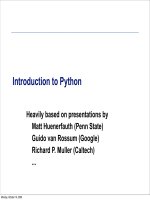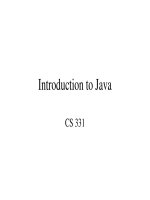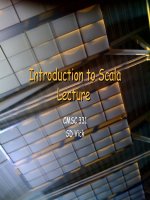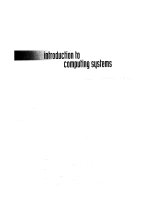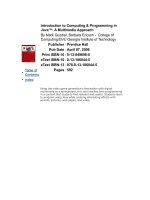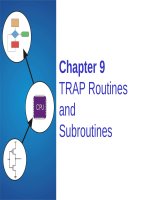Introduction to Computing: Lecture 7 - Dr. Pham Tran Vu
Bạn đang xem bản rút gọn của tài liệu. Xem và tải ngay bản đầy đủ của tài liệu tại đây (160.93 KB, 29 trang )
Introduction to Computing
Lectured by: Dr. Pham Tran Vu
1
Programming
- Programming languages
- Program design, testing, debugging and documenting
- Data structures
2
Programming Languages
Machine language
Assembly languages
High-level programming languages
Language processing
3
Machine Languages
Machine languages are the languages that can be
understood directly by computer processors
Code written using machine language (machine
code) can be executed directly by a computer’s
processor
Also known as native code
Each CPU model usually has its own machine
language or machine code instruction set
4
Machine Language (2)
Each machine code instruction performs a very
basic operation such as arithmetic calculations or
disk read/write operations
Each machine code instruction commonly has two
basic parts: opcode and operand, which are
expressed in binary
It is difficult to remember and use machine
language directly to solve real world problems
5
Machine Language Example
The following example code is written using Intel
80x86 machine code
It performs two operations: i=5 and j=i+10
Binary
Hex
10111000 00000101 00000000
b8 05 00
10100011 00000000 00000002
a3 00 02
10100001 00000000 00000002
a1 00 02
00000101 00001010 00000000
05 0a 00
10100011 00000010 00000010
a3 02 02
6
Assembly Languages
Assembly languages are low-level programming
languages
They are more readable than machine languages
An assembly language uses a symbolic
representation of numeric machine codes and
constants
Example: add, mov, sub, etc
Assembly code is translated to machine code by a
utility program called assembler
7
Assembly Language Example
Machine language
Assembly
10111000 00000101 00000000
b8 05 00
mov ax, 5
10100011 00000000 00000002
a3 00 02
mov [200], ax
10100001 00000000 00000002
a1 00 02
mov ax, [200]
00000101 00001010 00000000
05 0a 00
add ax, 10
10100011 00000010 00000010
a3 02 02
mov [202],ax
8
High-Level Programming Languages
A high-level language provides a high level
abstraction of computer programs
It is more natural to human languages
It allows programmers to use many more data
types and complex data structures
High-level languages are independent of computer
hardware
Examples: Pascal, C/C++, Java, etc
9
High-Level Language Example
A piece of C code
short i, j;
// define two variables i and j
i = 5;
// assign 5 to i
j = i +10;
// calculate i+10 and store the result in j
10
Generations of Programming
Languages (1)
First generation
Machine languages
Appeared in the 1960s
Second generation
Low-level languages, e.g. assembly languages
Third generation
High-level languages, e.g. C/C++, Pascal, Java
11
Generations of Programming
Languages (2)
Fourth generation
Easier to use than high level languages
Quick solutions to data processing task
Closer to natural languages
Non-procedural
E.g. Structured Query Languages
Fifth generation
More declarative
E.g. PROLOG, LISP and Smalltalk
12
Components of Computer Programs
Keywords
Reserved words used by programming languages
Identifiers
Names created by programmers given to variables or
constants
Scope of variables
The degree of accessibility (validity) of a variable
Global vs local scope
13
Components of Computer Programs
(2)
Data structures
Define the data types in a program
E.g.: numeric, character, boolean, pointer, arrays,
record, file, etc.
Operations on data
Arithmetic operations: addition, subtraction, etc
Logic operations: and, or, xor, nand, etc
Input and output
14
Components of Computer Programs
(3)
Control structures
Selections: if … then … else
Iterations: for, while
File handling
Open files
Close files
Read, write, delete
Functions and procedures
Subprograms
15
Components of Computer Programs
(4)
Blocking structures
Groups of statements
Parameters
Inputs to a function/procedure
Call by value
Call by reference
16
A Sample Program (1)
#include<stdio.h>
int cnt = 0;
void printRes(int [], int);
void findPer(int [], int, int);
void reOrder(int [], int , int, int);
void arrayCopy(int [], int [], int);
int main(){
int ars[] = {1, 2, 3, 4};
printf("test %d: \n", 4);
findPer(ars, 0, 4);
}
17
A Sample Program (2)
void arrayCopy(int ars1 [], int ars2[],
int size){
int i;
for (i =0; i < size; i++){
ars2[i] = ars1[i];
}
}
18
A Sample Program (3)
void reOrder(int ars[], int pick, int start, int size){
int temp;
int i;
if (pick == start){
return;
}
if (pick < start || pick >= size || pick < 0){
printf("Error, pick cannot be smaller than start\n");
return;
}
temp = ars[pick];
for (i = pick; i > start; i--){
ars[i] = ars[i-1];
}
ars[start] = temp;
}
19
A Sample Program (5)
void printRes(int ars[], int size){
int i;
printf("Cnt : %d \n", ++cnt);
for (i =0; i< size; i++){
printf("%d ", ars[i]);
}
printf("\n");
}
20
A Sample Program (4)
void findPer(int ars[], int start, int size){
int i;
int * temp = (int*)malloc(size*sizeof(int));
if (start == size - 1){
printRes(ars, size);
return;
}
arrayCopy(ars, temp, size);
for (i = start; i < size; i++){
reOrder(ars, i, start, size);
findPer(ars, start + 1, size);
arrayCopy(temp, ars, size);
}
free(temp);
}
21
Recursive Programming
A recursion happens when a function/procedure calls
its self
Example:
void findPer(int ars[], int start, int size){
...
for (i = start; i < size; i++){
reOrder(ars, i, start, size);
findPer(ars, start + 1, size);
arrayCopy(temp, ars, size);
}
free(temp);
}
22
Language Processing
Programs written in high-level languages need
to be converted to machine code for execution
A program written in a particular language
needs to be processed accordingly
How do we ensure that a program is written
correctly following a programming language?
How to define a language?
23
Computer Languages
Every programming language has a set of
rules to govern the syntax of well-formed
statements and sentences
This set of rules is called the grammar of the
languages
Each different language needs a different
way to process its programs according to its
grammar
24
Language Syntax
The syntax of a language describes possible
combination of symbols that forms a syntactically
correct program
Syntax is usually defined using a combination of
regular expressions and Backus-Naur form
Example:
expression ::= atom | list
atom ::= number | symbol
number ::= [+-]?['0'-'9']+
symbol ::= ['A'-'Z''a'-'z'].*
list ::= '(' expression* ') '
25
